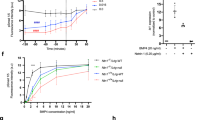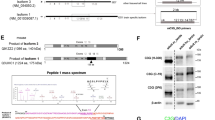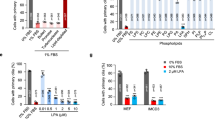Abstract
Ciliary neurotrophic factor (CNTF) is a cytokine supporting the differentiation and survival of various cell types in the peripheral and central nervous systems. Its receptor complex consists of a non-signaling α chain, CNTFR, and two signaling β chains, gp130 and the leukemia inhibitory factor receptor (LIFR). Striking phenotypic differences between CNTF- and CNTFR-deficient mice suggest that CNTFR serves as a receptor for a second, developmentally important ligand. We have identified this factor as a stable secreted complex of cardiotrophin-like cytokine (CLC) and the soluble receptor cytokine-like factor-1 (CLF). CLF expression was required for CLC secretion, and the complex acted only on cells expressing functional CNTF receptors. The CLF/CLC complex activated gp130, LIFR and signal transducer and activator of transcription 3 (STAT3) and supported motor neuron survival. Our results indicate that the CLF/CLC complex is a second ligand for CNTFR with potentially important implications in nervous system development.
This is a preview of subscription content, access via your institution
Access options
Subscribe to this journal
Receive 12 print issues and online access
$209.00 per year
only $17.42 per issue
Buy this article
- Purchase on Springer Link
- Instant access to full article PDF
Prices may be subject to local taxes which are calculated during checkout






Similar content being viewed by others
References
Stöckli, K. A. et al. Molecular cloning, expression and regional distribution of rat ciliary neurotrophic factor. Nature 342, 920–923 (1989).
Sendtner, M., Carroll, P., Holtmann, B., Hughes, R. A. & Thoenen, H. Ciliary neurotrophic factor. J. Neurobiol. 25, 1436–1453 (1994).
Arakawa, Y., Sendtner, M. & Thoenen, H. Survival effect of ciliary neurotrophic factor (CNTF) on chick embryonic motoneurons in culture: comparison with other neurotrophic factors and cytokines. J. Neurosci. 10, 3507–3515 (1990).
Oppenheim, R. W., Prevette, D., Qin-Wei, Y., Collins, F. & MacDonald, J. Control of embryonic motoneuron survival in vivo by ciliary neurotrophic factor. Science 251, 1616–1618 (1991).
Curtis, R. et al. Retrograde axonal transport of ciliary neurotrophic factor is increased by peripheral nerve injury. Nature 365, 253–255 (1993).
Sendtner, M. et al. Ciliary neurotrophic factor prevents degeneration of motor neurons in mouse mutant progressive motor neuronopathy. Nature 358, 502–504 (1992).
Mitsumoto, H. et al. Arrest of motor neurone disease in wobbler mice cotreated with CNTF and BDNF. Science 265, 1107– 1110 (1994).
Helgren, M. E. et al. Trophic effect of ciliary neurotrophic factor on denervated skeletal muscle. Cell 76, 493– 504 (1994).
Guillet, C., Auguste, P., Mayo, W., Kreher, P. & Gascan, H. Ciliary neurotrophic factor is a regulator of muscular strength in aging. J. Neurosci. 19, 1257 –1262 (1999).
Shi, Y. et al. Computational EST database analysis identifies a novel member of the neuropoietic cytokine family. Biochem. Biophys. Res. Comm. 262, 132–138 (1999).
Senaldi, G. et al. Novel neurotrophin-1/B cell stimulating factor-3: a cytokine of the IL-6 family. Proc. Natl. Acad. Sci. USA 96, 11458–11463 (1999).
Taga, T. & Kishimoto, T. Gp130 and the interleukin-6 family of cytokines. Annu. Rev. Immunol. 15, 797 –819 (1997).
Davis, S. et al. The receptor for ciliary neurotrophic factor. Science 253, 59–63 (1991).
Davis, S. et al. LIFR beta and gp130 as heterodimerizing signal transducers of the tripartite CNTF receptor. Science 260, 1805–1808 (1993).
Heinrich, P. C., Behrmann, I., Muller-Newen, G., Schaper, F. & Graeve, L. Interleukin-6 type cytokine signalling through the gp130/Jak/STAT pathway. Biochem. J. 334 , 297–314 (1998).
Masu, Y. et al. Disruption of the CNTF gene results in motor neuron degeneration . Nature 365, 27–32 (1993).
Takahashi, R. et al. A null mutation in the human CNTF gene is not causally related to neurological diseases. Nat. Genet. 7, 79–84 (1994).
DeChiara, T. M. et al. Mice lacking the CNTF receptor, unlike mice lacking CNTF, exhibit profound motor neuron deficits at birth. Cell 83, 313–322 (1995).
Ip, N. Y. et al. The alpha component of the CNTF receptor is required for signaling and defines potential CNTF targets in the adult and during development. Neuron 10, 89–102 (1993).
Li, M., Sendtner, M. & Smith, A. Essential function of LIF receptor in motor neurons . Nature 378, 724–727 (1995).
Elson, G. C. et al. Cytokine-like factor-1, a novel soluble protein, shares homology with members of the cytokine type I receptor family. J. Immunol. 161, 1371–1379 (1998).
Alexander, W. S. et al. Suckling defect in mice lacking the soluble haemopoietin receptor NR6. Curr. Biol. 9, 605– 608 (1999).
Trinchieri, G. Interleukin-12: a proinflammatory cytokine with immunoregulatory functions that bridge innate resistance and antigen-specific adaptive immunity. Annu. Rev. Immunol. 13, 251–276 (1995).
Kallen, K.-J. et al. Receptor recognition sites of cytokines are organized as exchangeable modules. Transfer of the leukemia inhibitory factor receptor-binding site from ciliary neurotrophic factor to interleukin-6. J. Biol. Chem. 274, 11859–11867 (1999).
Robledo, O. et al. Signalling of cardiotrophin-1 receptor: evidence for a third receptor component. J. Biol. Chem. 272, 4855–4863 (1997).
Robledo, O. et al. Binding interactions of LIF and CNTF with the different subunits of their high affinity receptors. J. Neurochem. 66, 1391–1399 (1996).
Zurn, A. D., Winkel, L., Menoud, A., Djabali, K. & Aebischer, P. Combined effects of GDNF, BDNF and CNTF on motoneuron differentiation in vitro. J. Neurosci. Res. 44, 133–141 (1996).
Anderson, K. D., Panayotatos, N., Corcoran, T. L., Lindsay, R. M. & Wiegand, S. J. Ciliary neurotrophic factor protects striatal output neurons in an animal model of Huntington disease. Proc. Natl. Acad. Sci. USA 93, 7346– 7351 (1996).
Miller, R. G. et al. A placebo-controlled trial of recombinant human ciliary neurotrophic (rhCNTF) factor in amyotrophic lateral sclerosis. RhCNTF ALS Study Group. Ann. Neurol. 39, 256–260 (1996).
Penn, R. D., Kroin, J. S., York, M. M. & Cedarbaum, J. M. Intrathecal ciliary neurotrophic factor delivery for treatment of amyotrophic lateral sclerosis (phase I trial). Neurosurgery 40, 94–99 (1997).
Aebischer, P. et al. Intrathecal delivery of CNTF using encapsulated genetically modified xenogeneic cells in amyotrophic lateral sclerosis patients. Nature Med. 2, 696–699 (1996).
Mittoux, V. et al. Restoration of cognitive and motor functions by ciliary neurotrophic factor in a primate model of Huntington's disease. Hum. Gene Ther. 11, 1177–1187 (2000).
Arce, V. et al. Cardiotrophin-1 requires LIFRbeta to promote survival of mouse motoneurons purified by a novel technique. J. Neurosci. Res. 55, 119–126 (1999).
Acknowledgements
E.L. is supported by an Association Française contre les Myopathies (AFM) grant. The authors thank K.J. Kallen at the University of Mainz, Germany for providing transfected Ba/F3 cell lines, V. Steimle at the Max-Planck Institute for Immunobiology, Freiburg, Germany for providing the pEBS-PL expression vector and C. Lacheny and F. Derouet for preparation of the anti-c-myc antibody.
Author information
Authors and Affiliations
Corresponding author
Rights and permissions
About this article
Cite this article
Elson, G., Lelièvre, E., Guillet, C. et al. CLF associates with CLC to form a functional heteromeric ligand for the CNTF receptor complex. Nat Neurosci 3, 867–872 (2000). https://doi.org/10.1038/78765
Accepted:
Issue Date:
DOI: https://doi.org/10.1038/78765
This article is cited by
-
Targeting IL-6 trans-signalling: past, present and future prospects
Nature Reviews Immunology (2023)
-
CRLF1 promotes malignant phenotypes of papillary thyroid carcinoma by activating the MAPK/ERK and PI3K/AKT pathways
Cell Death & Disease (2018)
-
Effect of human very low-density lipoproteins on cardiotrophin-like cytokine factor 1 (CLCF1) activity
Scientific Reports (2018)
-
Liuwei Dihuang Pill (六味地黄丸) Treats Postmenopausal Osteoporosis with Shen (Kidney) Yin Deficiency via Janus Kinase/Signal Transducer and Activator of Transcription Signal Pathway by Up-regulating Cardiotrophin-Like Cytokine Factor 1 Expression
Chinese Journal of Integrative Medicine (2018)
-
Stüve-Wiedemann syndrome: LIFR and associated cytokines in clinical course and etiology
Orphanet Journal of Rare Diseases (2014)



